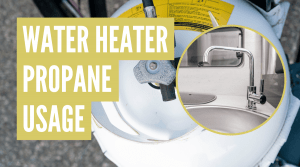Before you try to take a nice warm shower or use the hot water in your RV, you’ll need to make sure you’re RV water heater has been filled (and is on).
Luckily, filling your water heater is a simple, mostly hands-off task.
So, let’s learn how to fill an RV water heater two different ways, along with some important information, so you don’t ruin your heater in the process!
How to Fill an RV Hot Water Heater
There are two ways to fill an RV hot water heater: pumping water into it from the fresh water tank or by the pressure supplied by city water connected to your water hook up. Both ways require that your hot water tank is not in by-pass mode (a setting you would typically use when draining the water heater and winterizing the camper).
Related: How to Drain an RV Water Heater
In other words, like a home, your RVs water heater is a part of your plumbing. When you connect a hose to the city’s intake, water will flow through the pipes into the hot water heater. If you fill your RV water tank with fresh water, it will push the water into the hot water heater when you turn on the pump. Just turn on any hot water faucet in your motorhome and run it until the water starts to come out and there is no air in the lines.
It’s that simple. And the process is essentially the same for all water heater brands, including Suburban water heaters, Dometic (formerly Atwood) RV water heaters, etc. And it’s the same for all types, whether that be propane gas-powered, electricity-powered, or both.
IMPORTANT: Do NOT turn on an electric water heater until the water heater tank is full of water. If turned on when the hot water tanks empty, it will burn out the heating element. Check out our guide on how to turn on an electric water heater in an RV for more information.
How Do I Know if My RV Water Heater Is Full?
You can tell if the RV hot water heater is full by first ensuring your fresh water pump is “on”, or you are connected to city water, then turning on a sink or shower hot water faucet and letting it run until water continually flows out. If the water spits and sputters, run it until it flows out smoothly.
And don’t forget, if your hot water heater is equipped with a bypass kit, ensure the valves are not closed, which essentially forces the water in the plumbing system around the water heater (See diagram below for more information about bypass systems). This is especially important to check in Spring after pulling your RV out of storage for the Winter.
FAQs
Why Is My RV Hot Water Tank Not Filling Up?
The most common reason an RV hot water tank is not filling up properly is that one or more bypass valves are either partly or completely closed.

Depending on the type of system you have, ensure the proper bypass valves are open.
A few other possible reasons include:
- There’s a blockage at the water heater tank cold inlet port. Check the hose running from the bypass kit to the cold water inlet on the tank. And check that deposits inthe tank and/or crud on the anode rod hasn’t caused a blockage at the cold water inlet in the tank.
- The bypass valves are broken.
- The drain valve is leaking.
Refer to your owner’s manual for more troubleshooting tips.
Does an RV Hot Water Tank Fill Automatically?
Your RV hot water heater tank will fill automatically when you hook up to city water or turn your water pump on as long as it’s not being bypassed. Turn on a sink or shower hot water tap to help the water move through the system.
Where Is the Bypass Valve for the RV Water Heater?
The hot water heater bypass valve is located near the back of the water heater itself, typically where the cold water enters and the hot water leaves the tank. Depending on the bypass system you have, you will have between one and three bypass valves.
Related: Should I Leave My RV Water Heater on All the Time? (Important)







I have a Dometic water heater that does not have an on/ off switch. Turing the breaker off, would that be sufficient?
What model is your Dometic WH?
It is: GC6AA-10E 6 gal
That should have an OEM dual on/off switch. Unless the RV manufacturer did some really weird wiring, which wouldn’t surprise me. If there really isn’t an on/off switch then shutting off power to it via the breaker will suffice.
Yes, it has no on/off switch anywhere on the FRONT. It also is a different model from the documents included when I bought it new. RV Dealerships need better oversight.